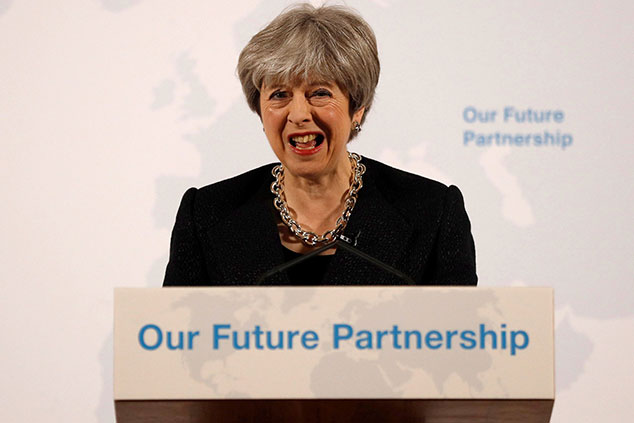
Theresa May is finally confronting the hard truths of leaving the EU. Matthew Partridge reports.
Theresa May’s speech on Friday was her “crunchiest and most substantial” intervention on Brexit yet, says Matthew d’Ancona in The Guardian. It plunged “into the weeds of policy”, acknowledged some “hard facts” and made explicit some obvious, but hitherto unstated truths. For Brexiteers there was the “repeated guarantee” that Britain “will leave the single market and customs union” and that parliament will be able to diverge from EU standards as “it sees fit”.
For Remainers, there was the reassurance that Britain will continue its association with a “host of EU agencies”, that May will be pragmatic about the future role of the European Court of Justice (ECJ), and that the UK “will not engage in a race to the bottom” on workers’ rights.
Starting from a weak position
Overall, the speech was “admirably frank, impressively argued – and about 18 months too late”, says an editorial on Bloomberg. The prime minister was right to acknowledge that there will be an economic cost to leaving the single market and customs union. She was also right to challenge the EU position that a tailored deal amounts to “cherry-picking”. “Every trade agreement is tailored” and the EU’s insistence on an “off the shelf agreement… makes no sense”.
What May failed to mention, however, is that Europe has no interest in making Brexit a success (it doesn’t want any more defectors) and that it can “drive a hard bargain” because a hard Brexit would hurt the UK far more than the EU.
The speech was less about telling the EU what the UK wants than telling the British what the UK can aim for, says Martin Sandbu in the Financial Times. There was an important shift from “red lines to negotiable demands” – on sovereignty, on ECJ jurisprudence, on “regulatory alignment”. Such pragmatism gives grounds for optimism.
The people must decide, not the PM
Nevertheless, it’s becoming “clearer by the day” that May, out of a sense of duty, is “leading the country towards a Brexit that she does not truly believe is in the national interest”, says Rachel Sylvester in The Times. Tellingly, she refused to give a “yes” or “no” answer when asked whether Brexit was “worth it”.
A growing number of MPs and peers advocate an extension of the Article 50 process, so that we don’t leave the EU until the end of the transition period rather than in March 2019. That would allow parliament a “meaningful vote on the terms of Brexit rather than just on broad principles”. There could also be a referendum on the final deal. “Why should the people not have the last word on such a momentous change”, if even the prime minister appears unconvinced by it?
Commissar May’s housing quotas
Theresa May has been “mercilessly mocked” for delivering her latest speech on housing against a backdrop of fake bricks, says the Evening Standard. But it was apposite, says The Daily Telegraph, given that the country has been “banging its head” against a wall for years as successive political leaders promise to solve the housing crisis only to “fail abjectly”.
It looks as though May will follow suit. Her acknowledgment of young people’s grievances doesn’t make houses any more affordable. Even her flagship promise to put pressure on council planning departments overlooks the fact that “there are more than 420,000 homes with planning permission waiting to be built”.
May’s plans might actually work – and that’s the problem, counters Simon Jenkins in The Guardian. Taking power away from councils who don’t build enough risks creating “the most savagely centralised planning regime” in history. At the same time, “housing targets are to be imposed on every local authority – irrespective of where they are or the state of local demand”. For all her talk of respecting “local wishes” and “character” her proposals were “written for the developer lobby”.
Building thousands of new homes in a field “won’t cut it”, says Myra Butterworth in the Daily Mail. Without amenities, developments won’t succeed. The problem isn’t a shortage of affordable houses, but houses in places that people want to live. Why not build infrastructure around existing homes in “less desirable locations” so that people want to live there?